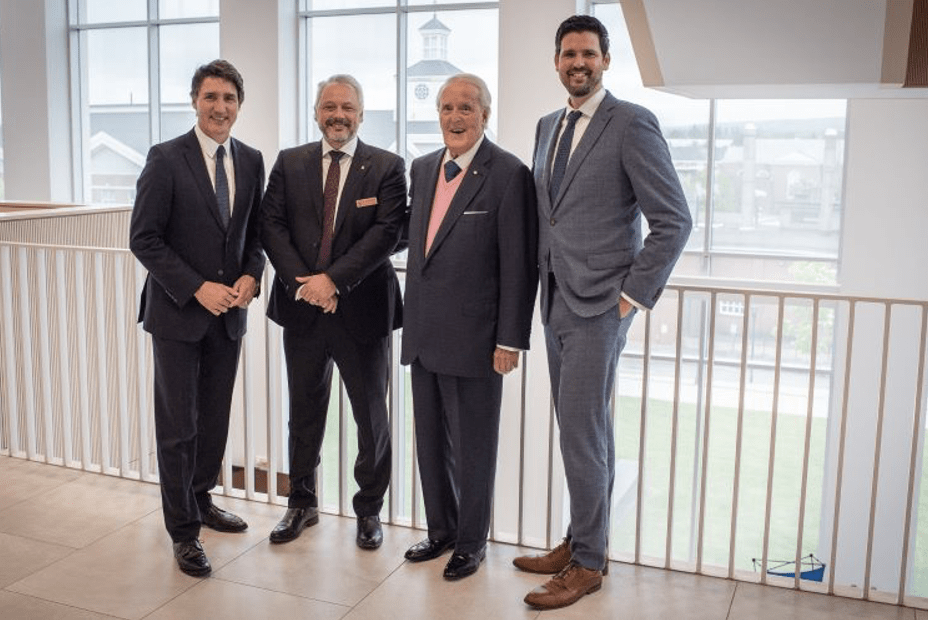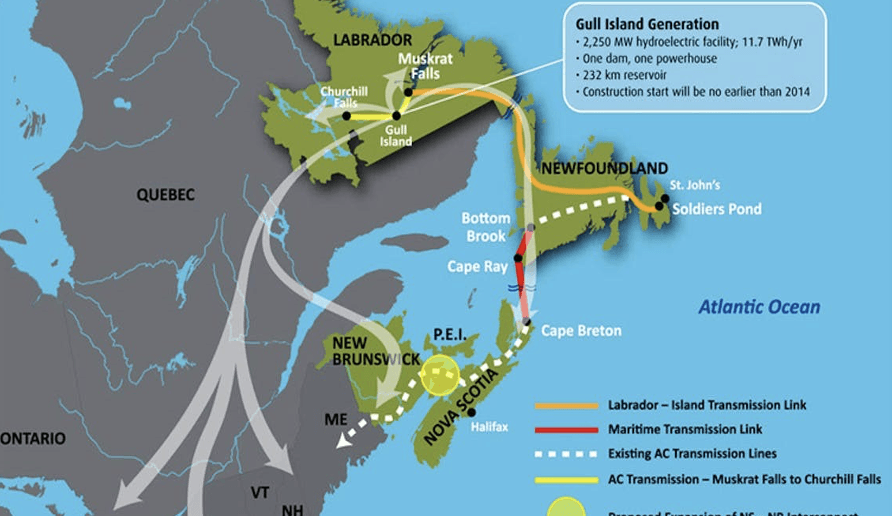The New Disparity: Atlantic Canada is Booming
 Charley McMillan and Prime Minister Justin Trudeau at the Atlantic Economic Conference/Adam Scotti
Charley McMillan and Prime Minister Justin Trudeau at the Atlantic Economic Conference/Adam Scotti
Charles McMillan
June 29, 2023
“Now this is not the end. It is not even the beginning of the end. But it is, perhaps, the end of the beginning.” This famous quote from Winston Churchill offers a fitting analogy for the new economic momentum of Atlantic Canada, once beset by decades of outward migration of young people, a demographic timebomb of fewer working-age employees and high public expenditures on education for young people and health care for seniors.
Thankfully, immigration trends are changing the population dynamics of the Atlantic region, doubling in numbers over the past 20 years, not even counting the number of immigrants who moved to Canada, then migrated to Atlantic Canada, in part for job opportunities but also much lower housing costs.
These issues were on full display at the first-ever Atlantic Economic Forum, held at the campus of St. Francis Xavier University, sponsored by the Brian Mulroney Institute of Government at St. FX June 19-21. More than 300 political, business, academic and other leaders attending, including the former and present prime ministers, Brian Mulroney and Justin Trudeau. The forum included a series of knowledge panels on diverse topics such as labour force transition, urban growth and housing, agriculture and agri-food, next generation technologies and startups, public finance and sustainable services (including health care), green economy and energy futures.
The outward migration of young people, and a workforce much older than the national average are now in reverse, with Atlantic cities facing population growth, young people staying in the region, and many forming part of a new startup culture. As David Chaudry, President of the Atlantic Economic Council set out early in the proceedings, the region still has a shortage of young workforce entrants to replace every ten retirees, 10 in 2006, 7 in 2020, and 8 in 2004, and much more pronounced in rural areas.
On the premise that demographics are destiny, Atlantic Canada in a post-COVID environment has turned the corner – more internal migration from other provinces, Atlantic Canada’s best and brightest starting new businesses, and a new and welcome acceptance of young immigrants, often with a global mindset, a startup mentality, and a willingness to think long term.
More immigration and population growth are the twin signs of a new, outward attitude in Atlantic Canada, despite the scars of the global pandemic and the Fiona storm that devastated up to 40 percent of forest lands, caused increased soil erosion, and impacted the need for new housing construction and many public buildings. All societies face similar problems, but for Atlantic Canada, they’ve fostered a new approach to resilience and a go-to-attitude toward new challenges.
Perhaps the most insightful and inspiring panels took place on the last day, appropriately also National Indigenous Peoples Day with discussions on Indigenous Business and Economic Development, chaired by Jarvis Googoo, Director of the Atlantic Indigenous Economic Development program, with an opening comment that Aboriginal people in Atlantic Canada see the region as a single unit, with their own network of contacts, including with similar Aboriginal networks across Canada and internationally. It is well-known that Aboriginal people are now the youngest and fastest-growing population (perhaps in the future the majority in Manitoba), and provide the solution to job shortages in many sectors.
The three panelists, Rose Paul, CEO & President Bayside Corporation; Mary Beth Doucette, Purdy Crawford Chair in Aboriginal Business Studies, Shannon School of Business, and Kelly Lendsay, CEO, Indigenous Works, gave case studies of collaboration across the region, the emphasis on education and training, partnering with local small business, and community involvement in growth strategies. “Few Canadians know that we are reducing our dependence on government from over 90 per cent to less than ten percent,” noted Lendsay, who also serves as CEO of the Aboriginal Human Resource Council.
 Prime Minister Justin Trudeau, St. F. X President Dr. Andy Hakin, the Rt. Hon. Brian Mulroney and the Hon. Sean Fraser in lobby of Mulroney Hall.
Prime Minister Justin Trudeau, St. F. X President Dr. Andy Hakin, the Rt. Hon. Brian Mulroney and the Hon. Sean Fraser in lobby of Mulroney Hall.
The themes of the conference agenda and the mood of participants were set on opening night, with both Prime Minister Mulroney and Prime Minister Justin Trudeau memorably underscoring the non-partisan nature of the event. The former prime minister shared his perspective on how history would view the legacy of his young successor, and the current one gave credit to the man former New Brunswick Premier Frank Mckenna called the “greatest Atlantic Canadian prime minister the region has ever seen,” Rt. Hon. Brian Mulroney. Trudeau spoke of the need for interprovincial cooperation, and the need to build on the widespread renewal with population growth, a new and impressive startup culture, and building on an educated workforce. He cited Antigonish’s own Tareq Hadhad, Peace by Chocolate CEO and new Canadian citizen, as an example of the 21st-century Atlantic spirit.
This Atlantic Canada momentum comes largely from Mulroney’s investment of time, resources, and forward thinking, including his vision and act of faith in the economic future of Atlantic Canada, via the creation of the Atlantic Canada Opportunities Agency(ACOA.) “He was very good at seeing potential,” mused Trudeau.
The current and former prime ministers headed a stellar lineup that included James Irving; Chief Terry Paul (CEO of Clearwater): Goldy Hyder from Business Council of Canada; Annette Verschuren, Chancellor of Cape Breton University and CEO of NRstor, Ken Langone, former CEO of Home Depot; Hon. Lisa Raitt and Anne McClellan, Coalition for a Better Future.
Deals big and small were on the table, but so, too, was a new vocabulary among the speakers; discussions and informative Q & As – startup, scaling, collaboration, competition, digital tools, regional cooperation, private sector funding, community involvement, self-reliance, deregulation, speeded of government approvals, dynamic ecosystems, silo mentality and a recurring theme of far less dependence on transfer payments and government support.
The conference coincided with new research studies, including the Public Policy Forum’s Atlantic Canada Momentum Index, with cities in Atlantic Canada showing fast population growth, a younger and more diverse labour sector, thanks in part to the demographics of more immigration, and young people staying in the region and absorbed in the new startup culture in the four Atlantic provinces, especially in the urban centres. (The CBC coverage of the report: From bubble to boom? New report shows economic momentum in Atlantic Canada.)
That culture has taken root within a growing science-based ecosystem with support from universities, government departments, the National Research Council, and the federal scientific research funding councils. There are impressive new outcomes, such as Canada’s Oceans Supercluster, with up to $25 billion in revenues forecast by the end of the decade; the booming biosciences sector expected to reach a billion dollars; the aerospace sector, with 50 local and international companies becoming part of the global supply chain for commercial aircraft production, space exploration, and software applications for drones, underwater and airline pilot simulators, as well as search and rescue.
In Brian Mulroney’s opening address and introduction of the prime minister, he spoke of the need for big, bold policies, pointing out that Atlantic Canada has often shown the way for the rest of Canada. As he put it, “If we remember the vision and dreams of our forefathers, who built this country, and now can count on us to carry it forward from generation to generation, from success to success, from one century to the next. That’s what we’re here for.” When McKenna recited the policy legacy of the former prime minister, he singled out the long-term investments in the future prosperity of the region, in energy, infrastructure, the environment, and science and technology.
This legacy, including the Atlantic Energy Accord, the Confederation Bridge, rebuilding the Canadian military with the shipbuilding program for frigates, and the creation of ACOA, were not top-down, Ottawa-driven programs. To the contrary, each of these was a bottom-up, community-based initiative with the collaboration of premiers, members of provincial legislatures, federal MPs, mayors, small business, and often representatives of community colleges and universities. But most also faced opposition including media attacks, and each consumed both time and political capital, but still led to successful and enduring outcomes.
Today, the region’s challenges are different. Urban centers in Atlantic Canada now face not only population increases, but shortages of affordable housing. But delegates discussed how this ‘problem’ can be turned in an opportunity. About 90 per cent of homes and apartments are constructed on-site, with weather and seasonality impacting the slow pace of construction. In Scandinavia, the vast majority of homes and apartments, as well as schools, are factory built in modular design, so there is an enormous opportunity to learn from Scandinavia for construction at home and for export.
Chief Terrance Paul, a discussant on agrifood and fisheries, has guided the Membertou First Nation in Cape Breton. The Membertou Development Corporation has a portfolio of 12 entities, including a trade and convention center, and the largest Indigenous investment ever in Canada in its acquisition of 50 percent of Clearwater Seafoods.
Another example was the powerful intervention by Annette Verschuren, chair and CEO of NRStor, an energy storage firm, and former CEO of Home Depot Canada. Verschuren highlighted the examples of recent dealmaking with Aboriginal communities, including a multimillion-dollar community-based investment in the Hamlet of Arviat, a remote community in Nunavut on the western shore of the Hudson Bay, incorporating wind, solar and energy storage to achieve meaningful diesel reductions. Both case studies are examples of forward-looking governance models that have resonance in many industrial and service sectors.
Energy policy and the shift to green energy sources – wind, solar, hydrogen, tidewater, hydro – is another example of a leadership role for the region. But it remains a contentious political issue, in part because the four provinces have applied different systems: nuclear in New Brunswick, coal in Nova Scotia, hydro in Newfoundland, and a mix in PEI, with an emphasis on wind farms. The thought that Atlantic Canada could be an clean energy powerhouse, to use the prime minister’s phrase, has potential, but requires a measure of collaboration in the region, and close alliances with other provinces, especially Quebec, with its deep expertise in hydro development, transmission, and venture funding.
Initiatives such as Churchill Falls and a major wind farm promoted by John Risley, formerly CEO of Clearwater, face headwinds of glacial approval processes by provincial governments. The proposed Atlantic Loop (see map below) is an example of the big, bold ideas touted by Brian Mulroney, including substituting hydro electricity from coal-fired plants, but bogged down in cost negotiations and who funds the bill, just as other jurisdiction committing huge investments in semi-conductor plants and big data storage units that consumer enormous amounts of electricity. Unspoken are the real costs of the Muskrat Falls electricity project that by-passes transmission from Labrador through the mainland of Quebec to New England via Newfoundland, Nova Scotia and New Brunswick.
 SaltWire
SaltWire
With hopes of final negotiations for the Atlantic Loop expected this year, with project completion by 2030, federal financing would come from the Canada Infrastructure Bank — according to recent budget documents, the government’s primary financing tool for supporting clean electricity generation, transmission, and storage projects, including for major projects such as the Atlantic Loop.
Despite new initiatives for regional cooperation in areas as diverse as energy, agrifood, healthcare, green energy, education, and immigration, the contentious subject of inter-provincial trade barriers emerged and a favourite topic for self-inflicted wounds by Atlantic Canada. Frank McKenna, a strong backer of free trade with the United States, rarely misses a chance to show the productivity losses of interprovincial trade barriers, about $80 billion per year. He could have added that these barriers, including against accepting professional credentials for doctors, nurses, and pharmacists from other provinces, also weaken the capacity of startup firms to scale quickly. His plea for reducing them had wide acceptance at the forum: “It’s a staggering commentary on our country that we can have free trade with Europe, with Asia, with the United States, but we don’t have free trade within Canada. So yes, we could do it within our Atlantic region.”
On that optimistic note, the delegates left the Atlantic Economic Forum with the conference motto – arrive with purpose, leave with actions. And a message to the conference organizers: À la prochaine.
Charles McMillan is Professor of Strategy at the Schulich School of Business, York University and author of several books, including Eminent Islanders and The Japanese Industrial System, and two reports for the Council of Atlantic Premiers. His most recent study, The Age of Consequence: The Ordeals of Public Policy in Canada, was published in 2022 by McGill-Queen’s University Press. His new book, Precision Agriculture and Food Production, is published by Cambridge Scholars.
